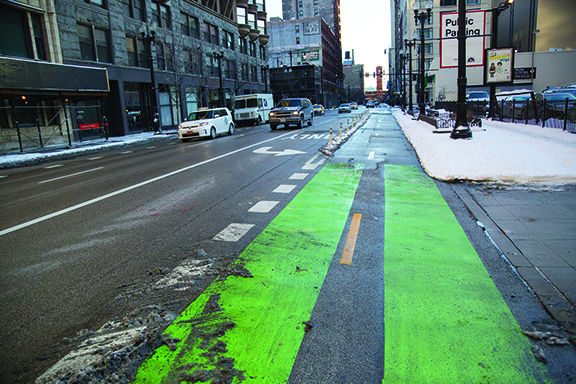Businesses getting up to speed with bike lanes

Dearborn Street bike lane
January 27, 2014
As the city strives to provide for its booming cycling population by creating more bike lanes, local business owners are promoting the bike-only lanes because of their potential economic benefit.
A Jan. 15 study by the People for Bikes and the Alliance for Biking and Walking shows that cyclists frequent area shops more than motorists because biking is more leisurely. A cyclist spends an average of $76 at local businesses per month, while motorists spent $61, according to the study.
“It helps for a bookstore or a grocery store to be on a street where there is a particular bike lane because you get more people who are passing by at low speed,” said Mary Lauran Hall, communications director for the Alliance for Biking and Walking. “They’re not speeding by in a car, they’re pedaling … so they see it, and the barrier of actually stopping and going into that business is much lower on a bicycle than it is for a car.”
Chicago is one of the country’s leading cities in the effort to increase the cycling population and the number of bike lanes, Hall said.
The city currently has more than 200 miles of bike lanes and Mayor Rahm Emanuel’s administration has created the Chicago Streets for Cycling Plan 2020, an initiative to implement more biking facilities and 100 miles of protected bike lanes by 2015.
The implementation of a bicycle lane near Alan Gillman’s hardware store, Gillman’s Ace Hardware, 2118 N. Milwaukee Ave., has resulted in an increased number of cycling customers within the last five years, he said. The bicycle lane near his shop has drawn local customers who prefer biking to driving or public transit and it has benefited his business overall, he said.
Despite the likelihood of increased business success along bike lanes, business owners along Milwaukee Avenue in the Gladstone Park neighborhood adamantly opposed the Chicago Department of Transportation’s proposal. During a Jan. 13 open house meeting, CDOT proposed replacing one lane of traffic in either direction, between Lawrence and Elston avenues, with protected bike lanes, which would decrease street parking, said David Wians, president of the Gladstone Park Chamber of Commerce.
Wians said less parking could be detrimental to businesses along the 1 1/2-mile stretch of Milwaukee Avenue because many businesses along that road cater to older residents who prefer to drive.
“In this community, it’s really not designed for [a protected bike lane],” Wians said. “I am a cyclist and I am all for it, but not at the expense of the business community. If the business community dwindles, so does the entire community.”
However, small business owners in other neighborhoods see bike lanes as a marketing tool. In Edgewater, bike lanes and corrals—structures used to secure bike lanes on public streets—have been effective in drawing customers, said Katrina Balog, executive director of the Edgewater Chamber of Commerce. She said many business owners have created bike parking in front of their stores and some businesses offer discounts to customers who bike to their locations.
Edgewater was one of 10 Chicago neighborhoods to have 25 bike corrals installed outside locally owned businesses, such as restaurants, to promote neighborhood economic development, according to a July 5 mayoral press release.
Chicago’s effort to install bike corrals and protected lanes, such as the one on Dearborn Street between Polk and Kinzie streets, are slowly paying off as more Chicagoans take to cycling, Hall said.
“It’s really a solution of getting people from point A to point B,” Hall said. “The business strengths hopefully will be a motivation for cities that haven’t started to build these types of lanes or who have started to keep on going.”







